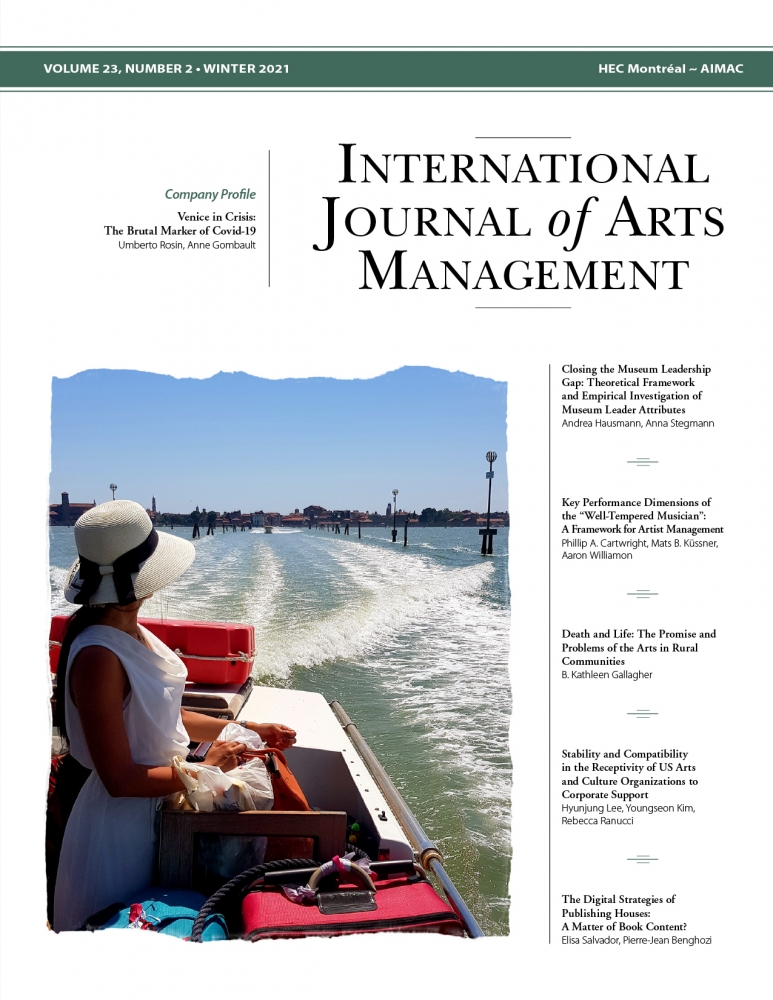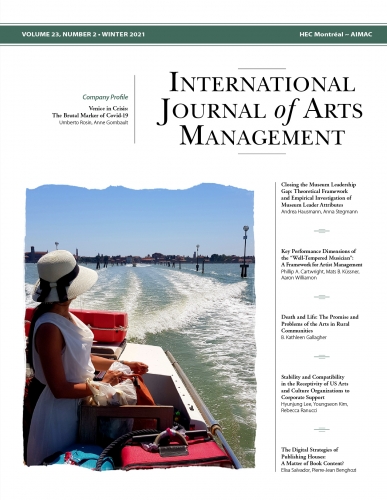IJAM Volume 23 Number 2 (PDF)
Product: Journal
$53.00 CA
FROM THE EDITOR
This Winter 2021 issue of IJAM provides an inspiring view of human resources, management, and marketing research in the realm of arts and culture. The topics of the articles relate to the performing arts, museums and book publishing.
In the first article, Andrea Hausmann and Anna Stegmann analyze the leadership models of German museums to identify 26 attributes required for a post in museum management. After reviewing 53 advertisements for executive positions, they report that museums focused predominantly on acquired leadership skills at the expense of personality-related traits. The authors recommend that museums focus more on a differentiated profile when selecting their executives.
Next, Phillip Cartwright, Mats B. Küssner and Aaron Williamon look at artist management as a fundamental element in an artist’s success, once it goes beyond standard business practices and extends into seven dimensions of artist identity. As it is unlikely that a manager will have expertise in all identity dimensions, outside expertise might be needed, as recommended by the authors.
In the third article, B. Kathleen Gallagher studies equitable access to public support among nonprofit arts and culture organizations (NPACOs) in relation to their size and geographic location. The author analyzes the financial filings of 132,337 NPACOs in the United States from 2005 to 2014. She reports a preponderance of small organizations outside of urban areas and discusses implications for arts managers and public funders.
The next contribution also looks at NPACOs in the United States, but this time in terms of the risk associated with corporate support. Drawing on data from NPACOs during the period 2004 to 2016, Hyunjung Lee, Youngseon Kim and Rebecca Ranucci find that organizational stability provided by public support, financial health and organizational experience led organizations to be less receptive to corporate support, because they did not want to destabilize their reputation. On the other hand, when more emphasis was placed on marketing in these organizations, compatibility with corporate partners was increased and the perception of risk associated with private support was reduced.
The fifth article in this issue of the Journal, by Elisa Salvador and Pierre-Jean Benghozi, examines online diffusion of e-books. By analyzing the categories with the highest number of books published, as well as the total number of titles available in print and digital formats for each publisher, they found that the digital strategies of 104 publishers in France varied according to the type of books published.
Finally, in the Company Profile, Umberto Rosin and Anne Gombault examine how the Covid-19 crisis has highlighted the overtourism situation in Venice and offer insights to overcome it in a post-pandemic world. The article illustrates, with creative scenarios, the need for a sustainable development plan for Venice’s man-made and natural heritage. I wish you insightful reading.
André Courchesne
Editor

